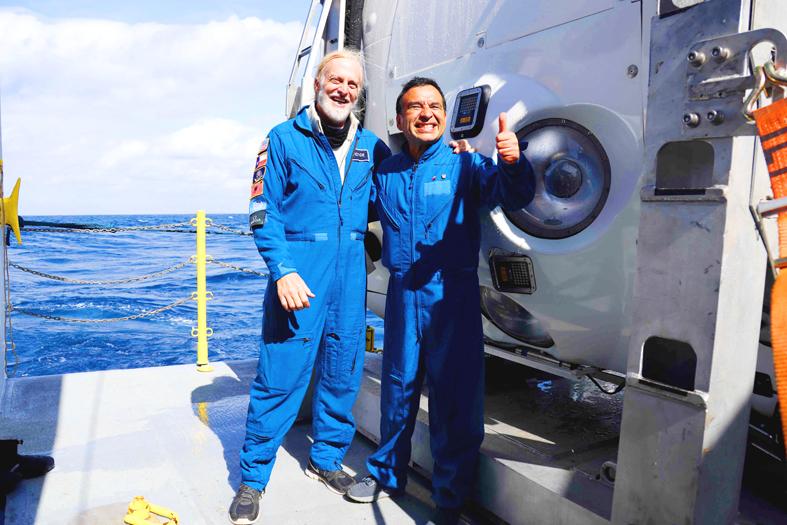When Chilean scientist Osvaldo Ulloa led an expedition 8,000m under the sea to an area where no human had ever been, his team discovered microscopic organisms that generated more questions than answers.
The January submarine expedition dove into the Atacama Trench, created by the meeting of two tectonic plates in the eastern Pacific Ocean.
“We pulled off the feat of taking humans into the trench where no other human being had been before,” said Ulloa, the director of the Millennium Institute of Oceanography at the University of Concepcion.

Photo: AFP / CALADAN OCEANIC - IMO / MATIAS PIZARRO
He was joined by US explorer Victor Vescovo and Millennium assistant director Ruben Escribano on the 12-week journey off Chile’s northern coast in the 5,900km long trench that extends up to Ecuador.
By the time the expedition reached a depth of 100m, it was already in pitch-black darkness, with the crew members’ vision limited to what the submarine’s powerful LED light could capture.
Further down in the darkness emerged remarkable examples of deep sea life.
“We came across geological structures, and there we saw a type of holothurians or translucent sea cucumbers, like jelly, that we had not recorded and were most probably new species,” Ulloa said. “We also discovered bacterial communities that had filaments that we did not even know existed in the Atacama Trench, and which feed on chemical and inorganic compounds. That opened up a huge number of questions: What are those compounds? What type of bacteria are they? We have no idea, we’re going to have to go back there.”
The expedition also found species of amphipods, a type of crustacean closely related to shrimp, which were scavenging other crustaceans, segmented worms and translucent fish.
They were discovered in the same place in another expedition in 2018.
The Atacama Trench is an area that has produced many earthquakes and tsunamis.
“We will put three sensors on the South American Plate and two on the Nazca Plate to see how the oceanic floor is deformed,” Ulloa said.
For the moment, “these types of sensors only exist on land,” he added.
The devices would enable scientists to observe where energy is building in areas that have not had an earthquake, thus helping predict where the next temblor would take place.
“It is an incredibly ambitious project,” Ulloa said, adding that it is “the largest experiment that has been done in underwater geology here in Chile.”
The sensors are due to be placed during the second half of this year.
“There is a lot of interest from the international community to put more sensors in this region to study all the processes associated with the collision of these two plates,” Ulloa said.

Kehinde Sanni spends his days smoothing out dents and repainting scratched bumpers in a modest autobody shop in Lagos. He has never left Nigeria, yet he speaks glowingly of Burkina Faso military leader Ibrahim Traore. “Nigeria needs someone like Ibrahim Traore of Burkina Faso. He is doing well for his country,” Sanni said. His admiration is shaped by a steady stream of viral videos, memes and social media posts — many misleading or outright false — portraying Traore as a fearless reformer who defied Western powers and reclaimed his country’s dignity. The Burkinabe strongman swept into power following a coup in September 2022

‘FRAGMENTING’: British politics have for a long time been dominated by the Labor Party and the Tories, but polls suggest that Reform now poses a significant challenge Hard-right upstarts Reform UK snatched a parliamentary seat from British Prime Minister Keir Starmer’s Labor Party yesterday in local elections that dealt a blow to the UK’s two establishment parties. Reform, led by anti-immigrant firebrand Nigel Farage, won the by-election in Runcorn and Helsby in northwest England by just six votes, as it picked up gains in other localities, including one mayoralty. The group’s strong showing continues momentum it built up at last year’s general election and appears to confirm a trend that the UK is entering an era of multi-party politics. “For the movement, for the party it’s a very, very big

ENTERTAINMENT: Rio officials have a history of organizing massive concerts on Copacabana Beach, with Madonna’s show drawing about 1.6 million fans last year Lady Gaga on Saturday night gave a free concert in front of 2 million fans who poured onto Copacabana Beach in Rio de Janeiro for the biggest show of her career. “Tonight, we’re making history... Thank you for making history with me,” Lady Gaga told a screaming crowd. The Mother Monster, as she is known, started the show at about 10:10pm local time with her 2011 song Bloody Mary. Cries of joy rose from the tightly packed fans who sang and danced shoulder-to-shoulder on the vast stretch of sand. Concert organizers said 2.1 million people attended the show. Lady Gaga

SUPPORT: The Australian prime minister promised to back Kyiv against Russia’s invasion, saying: ‘That’s my government’s position. It was yesterday. It still is’ Left-leaning Australian Prime Minister Anthony Albanese yesterday basked in his landslide election win, promising a “disciplined, orderly” government to confront cost-of-living pain and tariff turmoil. People clapped as the 62-year-old and his fiancee, Jodie Haydon, who visited his old inner Sydney haunt, Cafe Italia, surrounded by a crowd of jostling photographers and journalists. Albanese’s Labor Party is on course to win at least 83 seats in the 150-member parliament, partial results showed. Opposition leader Peter Dutton’s conservative Liberal-National coalition had just 38 seats, and other parties 12. Another 17 seats were still in doubt. “We will be a disciplined, orderly